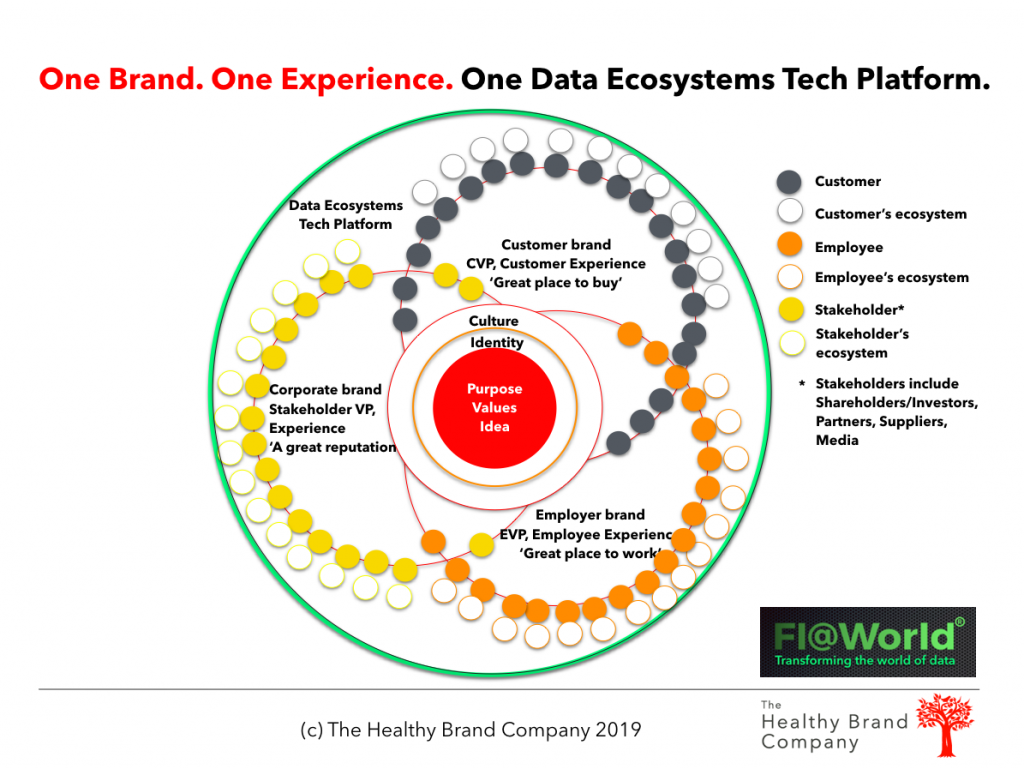Overview: This is the follow up article to “Redefining data ecosystems for the data economy” written for First 5000. In this article we explore the value of a single data ecosystem technology – that integrates internal and external, structured and unstructured data, from legacy systems and new technologies, in real-time, with data protections – in facilitating and enabling alignment of people, brands and data to deliver the hyper-speed, hyper-personalised, hyper-secure experiences people expect.
People and brands are two of your company’s most valuable assets
Leaders recognize that aligning people and brands has the power to attract, retain and engage employees, customers and stakeholders, driving business growth and raising brand value.
Yet in many organisations their value is not realised due to lack of alignment, between:
- The company’s and people’s purpose and values;
- Corporate, customer/product and employer brand strategies;
- Operational silos; and
- The promise the company is making to its employees, customers and stakeholders through its communications and their actual experiences.
Add an additional layer of complexity – the valuable asset that is data
Data – quantitative and qualitative, structured and unstructured, internal and external – is the opportunity to understand and strengthen the relationships between people, brands and business to unlock value and drive growth.
But lack of alignment serves to prevent easy and secure control of and access to data, from within and outside the organisation, and between employees, customers and stakeholders:
- People operate in silos with their own sets of data, technologies and systems that don’t talk to each other either within and outside of the organisation
- Many individuals don’t think data is their responsibility whereas data compliance, collaboration and capitalisation needs to be part of the culture and everyone’s responsibility
- Data compliance and security, privacy and permissions in using, sharing and integrating the data are not clear
- Exacerbated when combining legacy and new technologies, and M&A organisations
- There is no unified view of the customer or data of any entity, without expensive, time-consuming and risky stitching together of systems and data
Without alignment of people, brands and data, the experience is disjointed
As a result of lack of alignment of people, brands and data, customer, employee and stakeholder experiences are disjointed and not aligned to each other to ensure consistent delivery against the brand promise. A far cry from living up to people’s expectations of real-time, seamless, personalised, experiences that keep individual’s PII (personally identifiable information) safe.
Without one brand and a unified view of the customer or data of any entity, organisations cannot manage the complexity of experiences between its customers, employees and stakeholders to deliver consistently against the brand promise and business objectives.
A data ecosystem technology has the potential to align people, brands and data
Organisations need to align people and brands to business strategy, and they need a data ecosystem technology that facilitates the data that informs and inspires people and brand relationships to drive business growth.
You can read more about aligning people and brands here and here.
But what about the data ecosystem? To address the challenges above, the data ecosystem technology needs to:
- Be user-friendly, easy to implement, use and scale by individuals and teams in-house in order to support a data-driven culture
- Enable people to share, integrate and analyse data within and between organisations, legacy and new technologies, accessing data across operational and technology silos
- Efficiently handle high volumes of structured and unstructured data gathered across experience touch-points, internal processes and KPIs (key performance indicators)
- Have in-built privacy and compliance controls that enable sharing of permissible data between individuals and organisations
- Provide a unified view of the customer or entity
- Facilitate data that is useable and updatable in real-time, capturing data related to each data point, with the capability to feed analytics, machine learning/AI and deep learning models, to enable decision-making and action at point of interaction in real-time.
Deliver the hyper-speed, hyper-secure, hyper-personalised experiences people want
The combination of the strategy – aligning people and brands – and the technology – facilitating the data – enables organisations to deliver the hyper-speed, hyper-secure, hyper-personalised experiences that people expect and live up to the brand promise. Raising brand value and driving business growth.
Sound too good to be true? I’ve been fortunate to be working with transformative technology start-up Fl@World founders Michael & Kim McDonald and their data ecosystem technology, built upon years of experience in Tier One companies and Silicon Valley start-ups. Fl@World is designed to do this… and more… solving the data problems that organisations face today in order to open up opportunities for the future. You can find out more here.
Where do I start?
We’ve partnered with Chief Data & Technology Officer, Michael McDonald, to design our Data Strategy Benchmark Workshop specifically for organisations who are aware of the issues and opportunities surrounding their data, but aren’t sure where to start; or have started and aren’t sure where to go to next; and want an objective, external view of their data before they invest significant amounts of time, money, people resources on the area.
The workshop delivers a Data Strategy Benchmark against your organisation’s Strategic Business Vision and Plan. We work to initially understand your key business priorities and strategic drivers towards customer centricity, resource and process efficiency, agile organisation transformation, digital transformation, data security and compliance, brand reputation etc.
We guide a review of your entire data ecosystem of internal and external data sources across six key areas including: financial; operations, production and supply chain; data, insight, strategy, innovation and technology; brand, customer and marketing; people, culture and capability; legal, risk, compliance and security.
Together we develop the target state of data against your organisation’s future vision and compare it against the current state of data from the review, conducting a gap analysis to identify the key gaps that need to be filled.
Once written up, this provides the Data Strategy Benchmark that will provide you with the start point prior to developing a strategic roadmap, identifying priorities and how to fill the gaps, tactical goals and implementation.
Contact rachel@thehealthybrandcompany.com to find out more.




